|
|
| Clathrulina elegans, Cienkowsi, 1876 |
|
| Clathrulina elegans; Dunkelfeld. zwei oder mehrere Individuen können aneinander haften.Möglicherweise sind hier Mutter-und Tochter-Individuen zu sehen. |
 |
| Clathrulina elegans; Fokus auf den Gitterkäfig aus Kieselsäure |
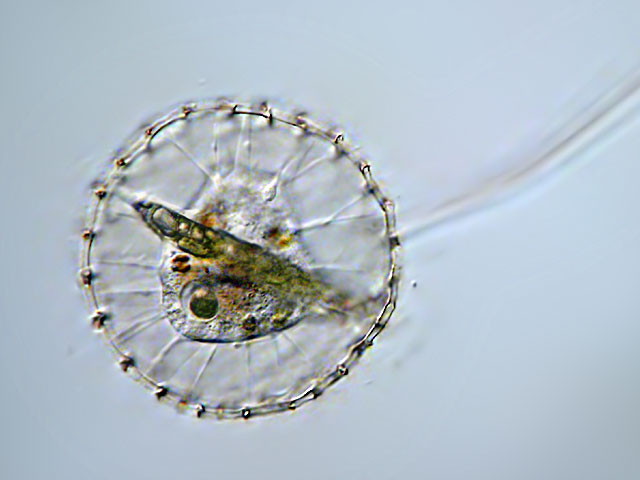 |
| Clathrulina elegans; Fokus auf den inneren Plasmakörper mit Pseudopodien, sowie als Beute eine Euglena sp. |
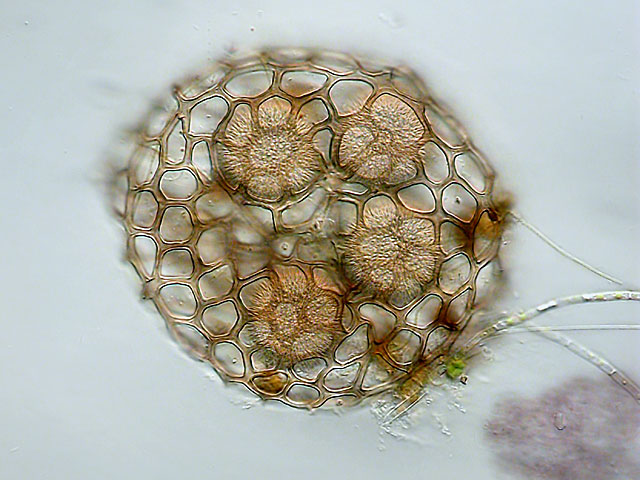 |
| Clathrulina elegans; Exemplar mit Cysten |
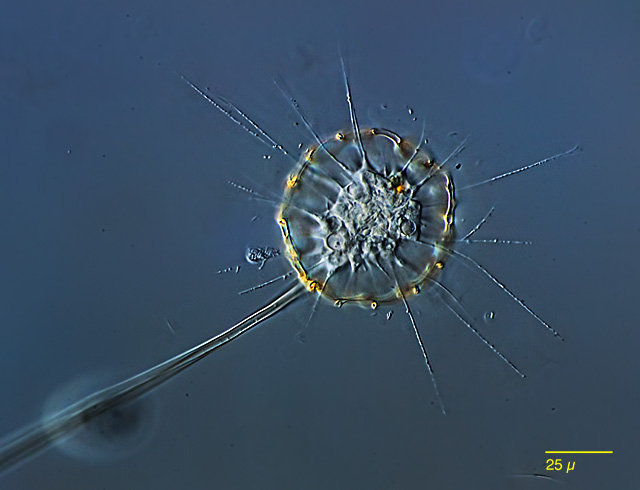 |
| Clathrulina elegans; Fokus auf die Axopodien (23.01.2011) |
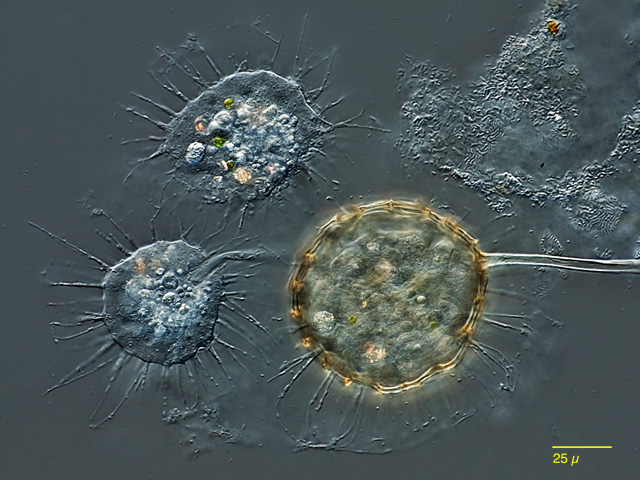 |
| Clathrulina elegans; Mutter-und Tochterexemplare (21.01.2011) |
 |
|
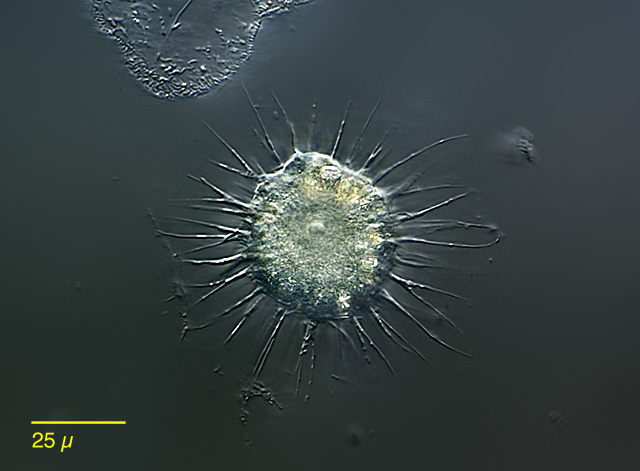 |
| Clathrulina elegans; junges Exemplar , ohne Stiel (20.01.2011) |
 |
| Clathrulina elegans; junges Exemplar , bereits mit Stiel, der im Plasma in der Nähe des Zellkerns inseriert (gelber Pfeil) (18.01.2011) |
|
|
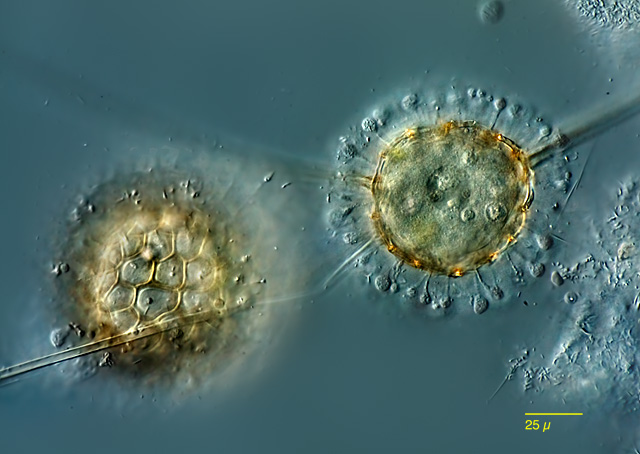 |
| Clathrulina elegans;vielfach wurde beobachtet, dass Zellplasma aus dem Käfig austrat, ohne dass die Zellen einem mechanischen Druck ausgesetzt waren (Sauerstoffmangel???) (23.01.2011) |
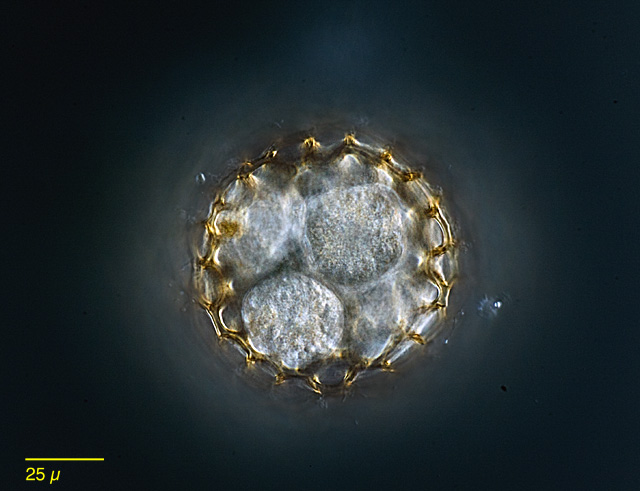 |
| Clathrulina elegans; beginnende Cystenbildung ??? (22.01.2011) |
|
| Fundort: Stefansbachtal Gevelsberg, Grünes Klassenzimmer , Teich |
| Habitat : Aufwuchs-Probe |
| Datum: 4.3.2009 (erster Nachweis seit 8 Jahren) |
|
|
|
| Hier ein Text der "Proceedings of the Academy of Natural Sciences of Philadelphia" von 1884 |
"Some Phenomena in the Life-History of Clathrulina elegans
BY SARA GWENDOLEN FOULKE.
While collecting infusoria among Lemna and the leaves of the yellow pond-lily, in a ditch on Brandywine Creek, Chester county, Pennsylvania, the writer was so fortunate as to secure large numbers of that beautiful Heliozoan, Clathrulina elegans. This rhizopod was attached in myriads to the roots of the Lemna, the groups in many cases being composed of above twenty-five colony-stocks, so matted together by the twisting of
the pedicels, and so surrounded by waste matter, as completely to conceal at that point the supporting root-fibre.
The animals were in a most active condition, feeding by means of their characteristic pseudopodial rays, and multiplying so reely by self-division, that the water was full of the Actinophrys-like bodies, and almost every capsule supported from one to ten young individuals.
After being kept in captivity for two weeks, the large social groups had decreased in number, although solitary individuals were much more numerous. Reproduction was still going on, but not so freely, and by more varied methods. The phenomena exhibited during the act of reproduction are the subject of this communication.
The modes of reproduction are four in number, two of these being slightly similar, while the others essentially differ in char-acter. These four modes are : first ^ by division ; second, by the instantaneous throwing off of a small mass of sarcode ; third, by the transformation of the body into flagellate monads ; and
fourth, by the formation and liberation of minute germs. By the first mode, and this is the most common, the sarcode mass within the capsule withdraws its rays, constricts, and divides into from two to four granular masses, which, after a varying period of rest, pass out from the capsule and instantly shoot forth pseudopodial rays on all sides, thus assuming the appearance of an Actinophrys sol. These Actinophrys-like bodies after a time develop a protoplasmic stalk, or pedicel, by which they attach themselves, usually to the parent capsule. A thin film of proto-
plasm is then thrown out and subtended by the rays, at a short distance from the body, and this, by development and secretion, becomes the latticed siliceous capsale. The pedicel also becomes
more rigid, though always retaining a degree of flexibleness.
This manner of reproduction was first described by Cienkowski, the great Russian observer, and discoverer of Clathrulina elegans (see Leidy's Rhizopoda of North America).
In the second mode of reproduction, the rays are not withdrawn, nor does the body divide, but the sarcode becomes finally vacuolate, presenting knob-like projections. Suddenly a small mass of sarcode, usually one of the knob-like projections, detaches itself, and, passing out of the capsule, shoots out rays and develops,
though more slowly, in the manner described above. This continues until the parent body is much reduced in size, when the rays again protrude and the animal returns to its normal condition.
The third mode of reproduction is by the formation and liberation of minute germs. In this state, also, the rays are not
withdrawn, but the body of the Clathrulina becomes filled with minute green particles, which, even before liberation, exhibit active motion. A number of these are expelled, enclosed in a thin protoplasmic film or globular sac, which bursts shortly, and the liberated germs swim away. The development of these germs, after this point, is yet to be followed.
The fourth mode is still more remarkable, and is also significant in bringing to light a new phase in the life-history of the
Heliozoa. The Clathrulina in which these phenomena were first observed, withdrew its rays and divided into four parts, as in the ordinary method ; but the sarcode, instead of becoming granular and of a rough surface, grew smoother and more transparent. Then followed a period of quiescence ; in this case of five or six hours duration, although in other instances lasting three days and nights ; after which one of the four parts began slowly to emerge from the capsule, a second following a few moments later.
While passing through the capsule, these masses of sarcode seemed to be of a thicker consistence than the similar bodies, which, in the ordinary method, instantly assume the Actinophrys form. After both had passed completely through, for nearly a minute they lay quiet, gradually elongating meanwhile.
Then a tremor became visible at one end, and a short prolongation of the sarcode appeared waving to and fro. This elongated at the same time into a flagellum, the vibrations becoming more rapid, until at the same moment both the liberated monads darted away through the water. They were followed for about ten minutes, when both were lost to sight among a mass of sediment, and the fear of mistaking one of the common monads for them
led the observer to abandon the search. Returning to the parent capsule, a third monad was found to have escaped in the meantime. After twenty-four minutes quiescence, the fourth body in its turn approached the wall of the capsule, emerged, developed a flagellum, and swam away, a free monad. With a one-half inch objective this one was closely watched, and the following details noted: body oval, transparent; nucleus present, dark- colored and situated near the centre ; a pulsating pink vesicle, situated posteriorly ; and a flagellum slightly longer than the body.
For one hour and fifty-eight minutes the monad swam in all directions, usually in concentric, ever widening circles, then suddenly darting off at a tangent to begin again in a new spot. At the end of this time, in its course it touched one of the free young Clathrulina and, to prevent it being used as food by its cannibal relation, the glass cover of the live-box was tapped, so that the current produced carried the monad a short distance away, where it remained almost motionless several seconds.
By a change to a power of three hundred and fifty diameters, the monad was shown to attach the top of its flagellum to the glass and revolve swiftly for a few moments, when instantly the whole body became spherical, rays were shot out, and the transformed monad was in no point, except that of size, to be distinguished from its Actinophrys-like cousin, whose career had been so different. In some cases the monads remained attached by the flagellum, using it as a pedicel. The whole development, from the time when the monad began its free life, occupied two hours
and some seconds. •
This mode of reproduction secures a more widespread distribution of the young than would be possible did this depend on the sluggish Actinophrys form. It seems reasonable to suppose that this is a wise provision for the perpetuation of the species, should adverse conditions of life arise ; and also to prevent an undue accumulation of the animals within a circumscribed space.
The tendency of these rhizopods to attach themselves to the parent capsule, a result of the inertness of the Actinophrys form of young; together with the fact that this mode of reproduction was apparently induced by a lengthened captivity, necessarily the source of adverse conditions, would point to the reasonableness of the above conclusions. " |
|
|
|
|